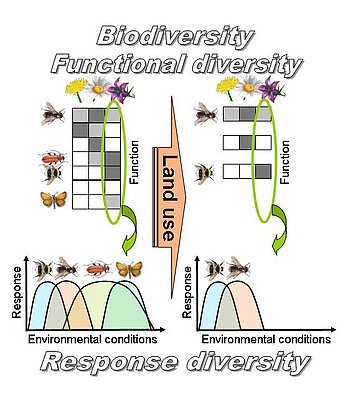Land use effects on response diversity in animal – plant interactions
Land use intensification is considered a threat to biodiversity and ecosystem functioning, but mechanisms and consequences are poorly understood. The goal of the proposed project is to understand how response diversity – in addition to the more commonly studied biodiversity and functional diversity – changes with land use. Response diversity is the prerequisite for the resilience of ecosystem functions, suggesting that the insurance of a system against disturbance relies on functionally ‘redundant’ species that differ in their responses to environmental changes.
We will investigate land use impacts on functional redundancy as well as response diversity, using plant-pollinator and plant-herbivore interaction networks as target systems.
The general hypothesis tested in this project is that land use intensity not only leads to a decrease in biodiversity, it also decreases
H1: the functional redundancy and
H2: the response diversity in communities.
These changes will correspond to
H3: a poorer resilience of the system to climate change
We
(1) survey quantitative plant-pollinator networks in grasslands and plant-herbivore networks in forests in the experimental plots,
(2) define functionally ‘redundant’ species for specified functions (pollination, herbivory) in each plot via network analysis, e.g. all insect species that pollinate a certain plant species or consume a certain tree species,
(3) relate changes in species relative activity densities to actual temperature conditions
(4) use laboratory mesocosm experiments on survival and performance under different temperature / humidity regimes for selected species, and
(5) define and compile response traits (phylogenetic, morphological, physiological and behavioural) to predict interspecific variation in responses.










